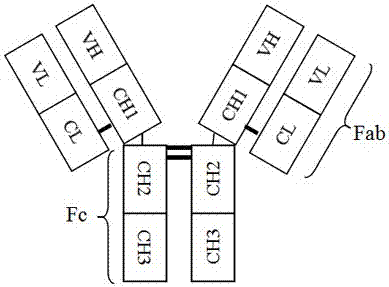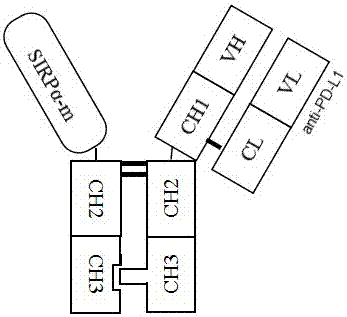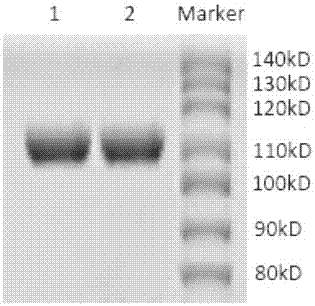CD47 and PD-L1 targeting bifunctional fusion protein
A fusion protein, PD-L1 technology, applied in the field of biomedicine, can solve the problems of insufficient efficacy and safety of antibody drugs, achieve good anti-tumor efficacy and blood safety, improve tumor antigen presentation, and improve tumor cell targeting. sexual effect
- Summary
- Abstract
- Description
- Claims
- Application Information
AI Technical Summary
Problems solved by technology
Method used
Image
Examples
Embodiment 1
[0043] Example 1. Construction and expression of a bifunctional fusion protein targeting CD47 and PD-L1
[0044] According to SEQ ID NO: 4 (encoding the fusion peptide segment formed by connecting the SIRPα mutant and the Fc segment of the antibody, with the Hole structure formed by mutations of Y349C, T366S, L368A, and Y407V), SEQ ID NO: 5 (encoding anti-PD- L1 antibody light chain), SEQ IDNO: 6 (encoding anti-PD-L1 antibody heavy chain, with Knob structure formed by mutations of T366W and S354C), synthesize the corresponding DNA fragments, and insert them into pcDNA3.1 vector respectively , Constructed into expression vectors pcDNA3.1-SIRPα-m-Fc, pcDNA3.1-antiPDL1-L and pcDNA3.1-antiPDL1-H, co-transfected into CHO-dhfr-expressing host cells, and inhibited with dihydrofolate reductase High-expressing clones were screened under pressure with methotrexate (MTX), and the high-expressing clones obtained were cultured in DMEM / F-12K medium (Thermofisher) under the conditions of 37℃ an...
Embodiment 2
[0045] Example 2. Purification of a bifunctional fusion protein targeting CD47 and PD-L1
[0046] The protein content in the cell culture fluid collected in Example 1 was determined by OD280 ultraviolet absorption method to be 1.5 mg / ml, and the pH value was determined to be 7.0.
[0047] Use a depth filtration system (Pall Company) to clarify and filter the cell culture solution. First use a depth filter with a pore size of 0.6-9μm to remove cells, cell debris and insoluble substances, and then use a depth filter with a pore size of 0.1μm or less to remove fine particles. Collect the filtrate.
[0048] The collected filtrate was purified by affinity chromatography, using GE's rProteinA Sepharose 4 FastFlow purification medium and Avant 150 protein purification system, and the sample was loaded at a dose of 30mg protein / ml medium, and the binding buffer was pH7.0 20mM phosphate buffer, Elution Buffer is 25mM citrate buffer with pH 3.5, flow rate 5ml / min, collect the eluate containin...
Embodiment 3
[0049] Example 3. SDS-PAGE electrophoresis identification of the bifunctional fusion protein targeting CD47 and PD-L1
[0050] Under reducing (dithiothreitol DTT) and non-reducing conditions, the purified fusion protein was identified by SDS-PAGE electrophoresis, using a polyacrylamide gel with a separation gel concentration of 7.5%, and a sample amount of 50μg protein per well , See the results of electrophoresis image 3 (Non-reduced SDS-PAGE), Figure 4 (Reduced SDS-PAGE), lanes 1 and 2 are two duplicate samples of the bifunctional fusion protein targeting CD47 and PD-L1. The electrophoresis results show that the molecular weight of the target protein is about 110kD and the purity is greater than 98%.
PUM
 Login to View More
Login to View More Abstract
Description
Claims
Application Information
 Login to View More
Login to View More - R&D
- Intellectual Property
- Life Sciences
- Materials
- Tech Scout
- Unparalleled Data Quality
- Higher Quality Content
- 60% Fewer Hallucinations
Browse by: Latest US Patents, China's latest patents, Technical Efficacy Thesaurus, Application Domain, Technology Topic, Popular Technical Reports.
© 2025 PatSnap. All rights reserved.Legal|Privacy policy|Modern Slavery Act Transparency Statement|Sitemap|About US| Contact US: help@patsnap.com



